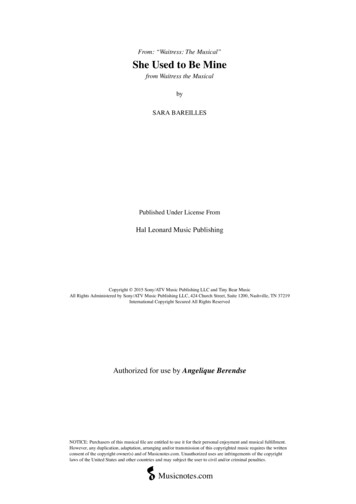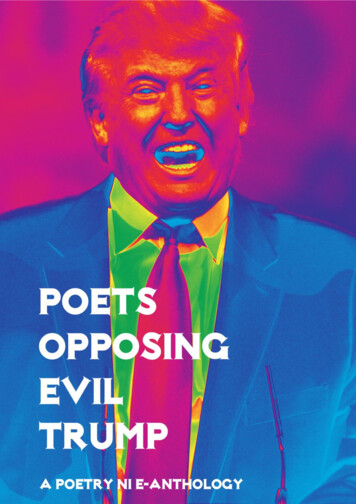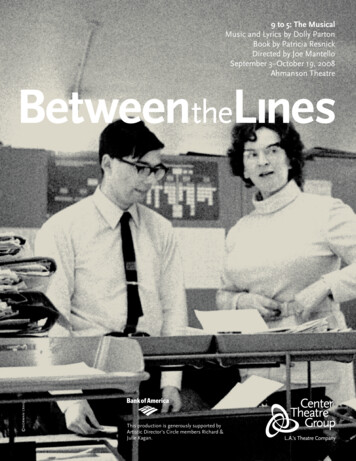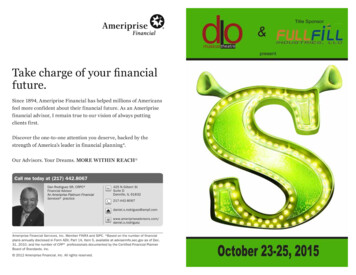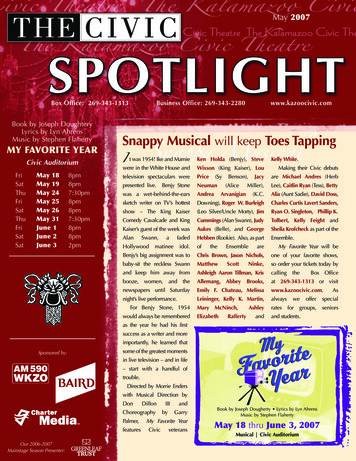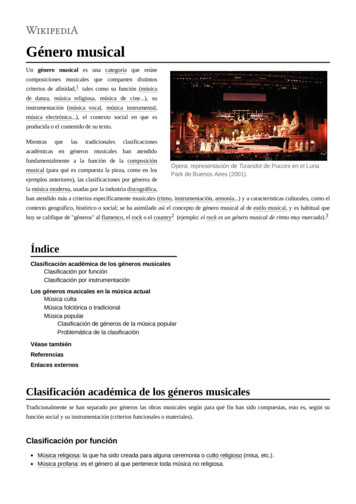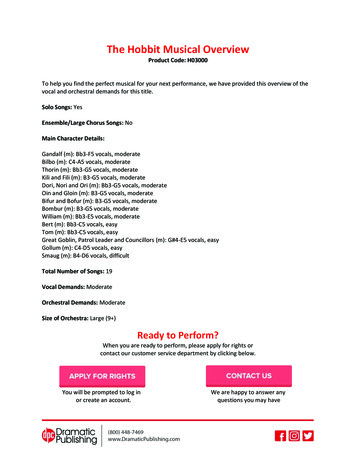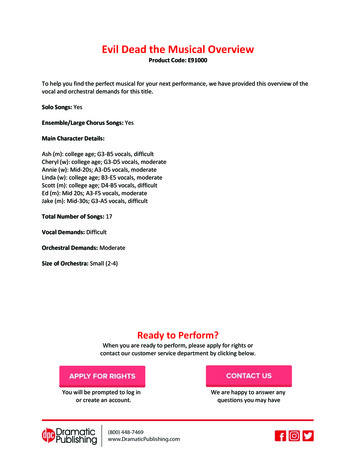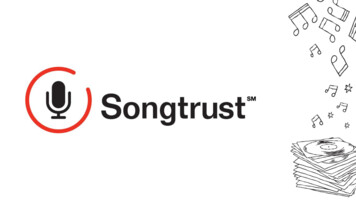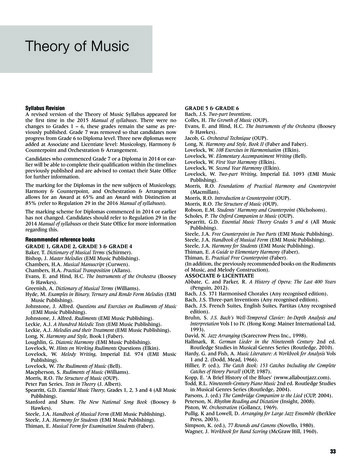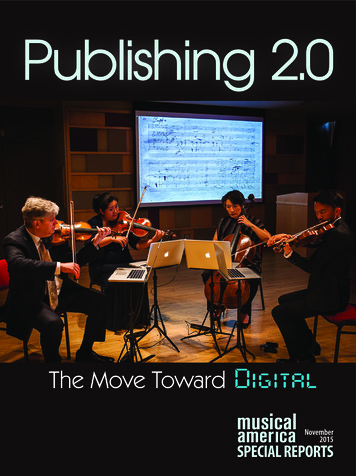
Transcription
Publishing 2.0The Move Toward DigitalNovember2015
IntroductionIt’s been nearly 14 months since our first MusicPublishing Special Report, and to say that there havebeen some major developments since would be a grossunderstatement. In keeping with trends in the field,we focus this time on the move to digital scores andtheir delivery. We wanted to find out where artists andorganizations are on the spectrum of print vs. digital.In a word: Everywhere.CONTENTS23Introduction7Digital vs. Print:Three Committed Converts9Digital vs. Print:Three Music Librarians Weighthe Pros and Cons14Digital Score Delivery—Finding a Universal ModelEditing in the New Age:Same Job, Different Tools18Accessing Music Scores on theWeb: Where to Look for What22More on the WebEach article in this issue is also foundon our website, MusicalAmerica.com,in the Special Reports section.Some aren’t even on it. At the Royal Opera House, Orchestra Manager TonyRickard sees no reason to move into the digital realm. “We’re still surprisinglyuntouched by technology,” he tells author John Fleming in Digital vs. Print: ThreeMusic Librarians Weigh the Pros and Cons. At the other end of the technologywand, Wu Han, Chamber Music Society of Lincoln Center’s co-artistic directorand a self-described “gadget freak,” sees little reason not to go digital. Keepingup with printed scores in the library is too labor intensive, she says, “when youmake it all digital, it’s so much easier.”In an attempt to get a sense of orchestra librarians’ preferences, G. Schirmer,in partnership with a number of other major publishers, sent out a survey tothe 200-member Major Orchestra Music Librarians (MOLA). Guy Barash, whodevised the survey, describes the results in his article, Digital Score Delivery—Finding a Universal Model. Virtually all of the respondents reflected a need fordigital materials, though certainly not to the exclusion of print.If digital delivery is a major change from delivery trucks dropping off paperscores at the stage door (see photo on page 4 ), so is music notation softwarea lightyear-leap from a team of copyists toiling over hemidemisemiquavers byhand. Maggie Heskin, director of editorial at Boosey & Hawkes, spells out theevolution for us in Editing in the New Age. (She also explodes a few myths aboutwhat music editors actually do.)With so many scores now available for download, it can be daunting formusicians and musicologists to find the best ones for their needs. Jane Gottlieb,VP for library and information resources at the Juilliard School, provides anoverview of where to look in Accessing Music Scores: Where to Look for What.Some of the collections she describes require a subscription fee, but the majorityof them are free, including libraries all over the world that have made theirholdings available on line at no charge.Regards,Susan ElliottEditor, Special Reports www.musicalamerica.com ß Special Reports 2015 ß 2015 all rights reserved.
Digital ScoreDeliveryBy Guy BarashThe demand for digital materials and distribution systems continues to rise, especiallyamong musicians and music organizations, from chamber ensembles to orchestras,opera companies, and choruses. In an effort to get a sense of its customers specificneeds in this area, Music Sales devised a survey to distribute among the 300 membersof the Major Orchestra Librarians’ Association (MOLA). Our goal was (and still is) tocreate a cross-platform web application for secure digital delivery of copyrightedconcert music materials, for use on tablet devices, laptops, desktops, digital musicstands, etc.Guy BarashGuy Barash is a composer of contemporary concert musicand a digital publishing specialist. As digital contentmanager and product owner for Music Sales Group,Barash leads the company’s digital initiatives, managesdigital content production, and oversees developmentteams both in the New York City office and overseas.The response rate to the survey was surprisingly high—about 40percent—and comments were positive. The results, excerpts ofwhich are shown in the following pages, were revealed at a panelentitled “Current and Future Delivery Methods of Rental Music”last spring to some 200 librarians at the 33rd MOLA Conference inMontreal. (Panelists included Elizabeth Blaufox, Boosey & Hawkes;Peter Grimshaw, BTM Innovation; Barash (Music Sales). Vi KingLim, of Symphony Services International, served as moderator.)Whose job to print?The respondents had confirmed that there was indeed a need forsuch a cross-platform distribution system, and that they are oftenapproached by musicians requesting digital parts and scores. Theirbiggest concern was, if by delivering materials digitally, wouldcontinued on p. 4www.musicalamerica.com ß Special Reports 2015 ß 2015 all rights reserved.
Digital ScoreDeliverypublishers be transferring to them the responsibility of printingand binding materials? The answer is no, they will not be requiredto print but will have access to digital materials until physicalsets arrive in the mail. We are looking to extend the existing printmodel with access to digital rather than to invent a new one, andto improve it where technology allows, providing, for instance,alerts to revisions of already rented materials. After hearing this,anticipated resistance quickly dissolved.On the other hand, there were a few librarians who specificallyinquired about the ability to print. As we are still in the process offormulating various access tiers, we are considering one that willinclude print capabilities as well.Score deliveries, circa 1910. Courtesy Schirmer Historical Archive.Music Sales has been working with other major publishers onthis project; at this point it seems inevitable that, together withThe need for a universal modelproviders and end-users, we will form a consortium. (This wouldWhatever system publishers come up with, it is essential that it be also spread the costs and increase the platform’s credibility.)universal. One doesn’t need to be a prophet to foretell the flop that Our goal is to prepare for present and future demands of digitalmultiple standards and solutions would be. Imagine how confusing materials in both sales and rental. The biggest challenge will beand totally ineffective it would be, for example, if in order to play to form that first group of founders and reach consensus on theThe Rite of Spring, an orchestra would need to download and details. After that, the technical challenges are relatively small. Ainstall the free Boosey & Hawkes iPad app, and to play Mathis der beta-testing program will launch soon, and many orchestras haveMaler, the same orchestra would need to pull out of storage the already signed up. Some have expressed interest in joining ourSchott system (comprised of Android tablets connected to a Linux advisory board.terminal) that they just recently purchased. Ouch.The new platform holds the potential of being not only adelivery mechanism, but also a powerfuldiscovery tool where users can explore musicthat was tagged by others with programmingparameters like mood, style, era, etc.Easier access to performance materialswill also be an invaluable tool for scholars,teachers, reviewers, and program-noteannotators. It will improve the process ofBeing small means that we have time to pay attention to ouronline grant and performance applicationsartists. The buck stops here and if the buck doesn’t work, weand offer a new and improved distributionbutcher him and eat him.channel, not just for the big players, butPlanning a recording? Have lots of questions? Download a freefor smaller publishers and self-publishedPDF on recording on our Submissions page.composers as well. We have reached aWant to see our packages and artists’ reviews? See them oncritical mass—the point of no return forour Publicity page.an expedition to explore our joint futureof digital-delivery options for rehearsingand performing.Don’t tell us we’re small.We know it. We like it.ConBrioRecordings.comcontinued on p. 6 www.musicalamerica.com ß Special Reports 2015 ß 2015 all rights reserved.
7KH SUHPLHU FRQIHUHQFH IRU VRQJZULWHUV FRPSRVHUV DUWLVWV DQG SURGXFHUV 5HJLVWHU 1RZ ZZZ DVFDS FRP H[SR
Digital ScoreDeliveryQ: H ow important is digital delivery of scores to musicorganizations?A: VeryThe following represents some of the results of a recent survey conducted among the members of the MajorOrchestra Librarians’ Association.Very 5%Moderatelyimportant28%Very important31%Very nt24%Very nt22%Very important21%Source: Musical Sales Corp./G Schirmer Inc. www.musicalamerica.com ß Special Reports 2015 ß 2015 all rights reserved.
Digital vs. PrintThree Committed ConvertsMany soloists and chamber groups have completely abandonedpaper scores for tablets and iPadsBy John FlemingViolinist Ray ChenRay Chen is a pioneer among digital-reader users.Ray Chen deserves at least a footnote in the history of digital scores.He was one of the first to play from a digital music reader in amajor competition. At the 2009 Queen Elisabeth Competition inBelgium, he used a laptop, with a foot pedal for page turns, to playa commissioned work for violin and piano, V , by Claude Ledoux.“The work was very difficult, full of complex rhythms, withimpossible page turns, and most people in the competition eitherhad to print out extra sheets of music and put it across like threestands or make a giant billboard,” Chen says. “But since pageturning wasn’t a problem, instead of just playing the single line ofthe violin and having no clue of what the piano was doing, I usedthe whole score, so I could see the overall map of the piece. ThatJohn FlemingJohn Fleming writes for Classical Voice North America,Opera News, and other publications. For 22 years, hecovered the Florida music scene as performing arts criticof the Tampa Bay Times.Chen in his winning performance at the 2009 QueenElisabeth Competition.really saved my butt in the competition and enabled me to focuspurely on the music.” (There’s a video of the performance on thecompetition web site.)Chen won the competition, and ever since the iPad came outin 2010, it has been his constant companion as he performs aroundthe world. For most concertos, he will have the work memorizedand doesn’t use the device (though he played Britten’s First ViolinConcerto from it last year with the Buenos Aires Philharmonic),but for chamber music it is invaluable. “For anything that’s not aconcerto—for the sonatas, for the quartets, quintets and trios thatI play—I’ll have the iPad there,” he says.The specifics of his setup are typical of digital score users:His iPad is connected to a Bluetooth foot pedal from AirTurn, acompany that makes wireless page-turners that was co-foundedby Hugh Sung, a pianist and former faculty member of the CurtisInstitute of Music, where Chen studied. He scans sheet music uscontinued on p. 8www.musicalamerica.com ß Special Reports 2015 ß 2015 all rights reserved.
Digital vs. PrintThree Committed Convertsing his smartphone camerawith software by TurboScan,and the app forScore allowshim to make annotations tothe score.“It’s easy to use,” Chensaid. “You don’t have to betech savvy. I basically turnit on.”AirTurn wireless page-turner.The Borromeo String QuartetThe Borromeo String Quartet, which began using digital readers in2007, was an early adopter of the technology for strictly musicalreasons. First violinist Nicholas Kitchen wanted to have the groupread music from the full, four-part score rather than from individualparts, as is customary in most ensembles. Playing, say, a Beethovenquartet from the full score would take more than 100 page turns,many in very inconvenient places. With a foot pedal, however, theturns are virtually seamless.The Borromeo String Quartet members use their computers to see the full, fourpart score as they play.“Once you get the hang of turning pages with your foot, thereis no barrier to having a score with as many pages as you wish,”says Kitchen, who reads his music off a MacBook Pro that has a 17inch screen, larger than an iPad. “And reading from the completescore all the time has been a profound, wonderful change.”Cellist Matt HaimovitzMatt Haimovitz plays off his iPad, through which he stores morethan 750 scores in the cloud, accessible at the flick of a finger. “IMatt Haimovitz stores some 750 scores on The Cloud, accessible on his iPad.can travel anywhere and I have all those scores with me,” Haimovitzsays. “When I change up a program, or decide on the spot to playan encore, it’s all right there.”He annotates his scores using forScore and a stylus. “A settingallows you to mark it up in different colors, which is easy on theeye and the brain,” he said. “I can quickly go in there and changesomething. If I’m playing a Brahms piano trio with one violinistand pianist, and then two weeks later I play the same piece withdifferent people, I can save a version of the score for each group,with different markings. I don’t have to see all the erasures andmarkings that I would have had to make on paper.”In four years of playing from an iPad, Haimovitz has beenremarkably free of glitches. “I’ve had it crash only once in concert,and that was partly my fault because I upgraded the forScoresoftware without upgrading the operating system, so it just wasn’thappy,” he said. “It was in the middle of a Brahms piano quartetat the Beaux Arts Museum in Montreal. Fortunately I rememberedthe rest of the piece and was able to go on, but I was like a deer inthe headlights.”Haimovitz commissioned six composers—Philip Glass, DuYun, Vijay Iyer, Roberto Sierra, Mohammed Fairouz, and Luna PearlWoolf (his wife)—to write overtures for the J.S. Bach Cello Suites,using the manuscript copy by Anna Magdalena, Bach’s secondwife. “I got the overtures digitally,” he said before they were to bepremiered this fall. “The composers sent me PDFs that went directlyinto my iPad library, and we made any revisions digitally. In thepast we would have been mailing sheet music back and forth. Idon’t know how we did it.” www.musicalamerica.com ß Special Reports 2015 ß 2015 all rights reserved.
Digital Printvs.Music LibrariansThreeWeigh theBy John FlemingPros ConsandWhile it’s no longer a novelty to see soloists and chamber musiciansplaying off a digital reader like an iPad [see Three CommittedConverts], symphony, opera, and ballet orchestras are still largelywedded to paper. Will that ever change? And if so, how? When?These are questions pondered by many a music librarian, who dealwith huge stacks of printed scores and instrumental parts, not tomention the constant shipment of rented sheet music back andforth to publishers. Here’s how librarians at three organizations arebalancing digital vs. print.Chamber Music Society of Lincoln CenterChamber musicians are among the early adopters of digital readers,especially Wu Han, co-artistic director of the Chamber MusicSociety of Lincoln Center. “I’m a gadget freak,” says Wu, who usesan iPad to read scores and store her music library. The devices areespecially attractive to pianists because they can solve the page-John FlemingJohn Fleming writes for Classical Voice North America,Opera News, and other publications. For 22 years, hecovered the Florida music scene as performing arts criticof the Tampa Bay Times.turning problem with a foot panel. [See sidebar: Page turners arenice people, but .]“The digital score, for me, is the way to go,” Wu says. “Ourphysical library is filled with shelves of paper music, and it is verytime-intensive to keep it in good order. The artists come in andout, they pull music,parts go missing,and then we have toreorder it, rebind it,and re-categorize it.Or if we decide not tolet the parts out, thenif an artist wants apart, we have to copyit. And that’s alsoRobert Whipple, library manager for thecumbersome and timeChamber Music Society of Lincoln Center.consuming. When youmake it all digital, it’s just so much easier to control.”Enter Robert Whipple, librarian and operations manager, whois just a few years out of the Sunderman Conservatory at Gettysburgcontinued on p. 10www.musicalamerica.com ß Special Reports 2015 ß 2015 all rights reserved.
Digital vs. PrintMusic LibrariansThreeWeigh theCollege and now in his fourth season with theSociety. He has been charged with helping tobring the 46-year-old organization into thedigital age. “It is a priority,” Wu says.Whipple spends quite a lot of timescanning scores and parts into PDFs that areuploaded onto servers and organized withArtsVision, a software program used by theCMS to manage data. “Usually, before theseason starts, I scan most of the music that’sgoing to be performed,” he says. “That way,if people need music, I don’t have to make acopy, I already have it uploaded so I can justprint it out or send them a PDF.”The Chamber Music Society is still along way from having anything like a complete digital library, butWhipple is making progress. “Previously, we didn’t scan everything,Pros ConsandWu Han plays from her iPad while Gilbert Kalish prefers the traditional printedpage in a performance of Bartok’s Sonata for Two Pianos and Percussion.PHOTO: Hiroyuki Ito10 www.musicalamerica.com ß Special Reports 2015 ß 2015 all rights reserved.continued on p. 11
Digital vs. PrintMusic LibrariansThreeWeigh thePros Consand“ Page turners are very nicepeople, but ”The problem of page turns has drawn many pianiststo digital technology. In chamber music, pianiststypically play from full scores that, since they can’tbe turning pages all the time, require them to havepage turners next to them. “Page turners are verynice people, but if you don’t get a good one, it’s hellonstage,” says pianist Wu Han, co-artistic directorof the Chamber Music Society of Lincoln Center.“The digital reader not only gets rid of that, but it’sgreat for radio broadcasts and recordings. There’s nopaper noise.”She reports that about half the pianists on theChamber Music Society roster use digital readers,such as Gloria Chien, Inon Barnatan, and JuhoPohjonen, but among string players, only about 10percent do. One who does not is her co-director andhusband, cellist David Finckel. Says Wu with a shrug:“He just doesn’t like it.”but I have been pushing for it because it’s ultimately easier,” hesays. “If I have everything scanned, I don’t have to copy things yearafter year. Once something is scanned, it’s in the system forever. SoI’ve just been doing that each season—everything we play, if notall the parts, at least the scores.”More players are using digital readers for practice. “I’d say it’sabout half and half between musicians asking for PDFs versus hardcopies,” Whipple says. “A lot of people who may not be reading offof [a tablet] in concerts still request scores or parts digitally so theycan look at the music another way, or just for quick access to ascore if they have a question.”The CMS has an extensive touring program, and it’s notunusual for Whipple to get a call from a musician in the field whoneeds a part in a hurry. “Once I’ve scanned something in, they canprint it out wherever they are. It’s great for emergency situations.”Unlike the symphony orchestra and opera librarians canvassedfor this article, Whipple is not so concerned with includingannotations on scores, such as bowings. For the most part, chambermusicians do their own. “I like scans to be as clean as possible sothat anyone in the future could make their own notes,” he says.“I erase excessive markings before getting music to the players,though it can be valuable to have some minimal marking in thepart if it’s a lesser-played piece.”For all of Whipple’s digital orientation, the Chamber MusicSociety and its librarian still have an old-school backup: “Anytimewe do a performance we always have paper copies backstage.”Royal Opera House“We’re still surprisingly untouchedby technology,” says Tony Rickard,who has been manager of the libraryof the orchestra of the Royal OperaHouse at Covent Garden since 2007.“My colleagues in the library spend most of the day working withpencil and eraser on paper.”No one plays from a digitalRickard, libraryreader in performance—uniformity Tonymanager for the Royal Operais the rule in the orchestra, and House Orchestra.besides, the screens of most tablets are too small to accommodatethe traditional two string players per part. Rickard has haddemonstrations by manufacturers of paper-free electronic musicstand systems, such as eStand in the United States and Scora ineStand score readercontinued on p. 12www.musicalamerica.com ß Special Reports 2015 ß 2015 all rights reserved. 11
Digital vs. PrintMusic LibrariansThreeWeigh theEurope. With music on all stands linked, a conductor (or librarianor even publisher, theoretically) can send annotations from acentral device to everyone’s parts. Some see this as the future fororchestras. Rickard is not so sure.“The main problem that it seems to solve is the one of pageturns, particularly with long orchestra pieces, and you can imagineopera parts that go on forever. But it doesn’t really seem to solvemuch else that couldn’t be solved in other ways, taking into accountthe cost and inconvenience of switching to a new system.”Rickard figures that the Royal Opera would need a digitalsystem for up to 100 players in the orchestra. “At a rough estimate,”he says, “you’re probably looking at 60,000 euros [about 67,000]or more to replace a paper system that works fine. And what aboutthe built-in obsolescence of most technology? Would we need tobuy a new system every few years? This is probably me just beingold-fashioned, but I don’t see it happening.”Then there’s the issue of reliability. To work properly, theScora system needs strong, uninterrupted wifi—not always a surePros Consandthing. “What you really couldn’t have is a performance conkingout because of some technical glitch. It happens occasionallyonstage but there you can sort of see when it isn’t working,and the audience has a tolerance for it. But if the music stands godown, I don’t think that would go over very well.”With its history reaching back to Handel’s appointment asmusical director, in 1719, the Royal Opera has a vast stock of musicon paper, which includes not just opera but also ballet, storedthroughout its building and offsite. Where digital technology oftencomes into play now for its librarians is when they use software likePhotoshop or Sibelius for notation to prepare new sets of standardrepertory. “Fixing page turns, bar numbers, bowings, errata, thatsort of thing,” Rickard says, citing recent projects to clean up LaTraviata and Eugene Onegin scores.They also move into the digital realm with commissions,especially with the the inevitable last-minute changes. WhenThomas Adès’s The Tempest was set to premiere at the RoyalOpera, the libretto was rewritten very late in the process. Insteadof working from a printed score, as is customary, the companyreceived a stream of revisions digitally from the publisher.“Adès made quite a lot of edits after having heard rehearsals,and then it was my job to implement them,” recalls Rickard. “Inthe old days, we would have had couriers running around Londonall day, every day, but I was able to make the changes from PDFs.A similar situation happened with Mark-Anthony Turnage’s AnnaNicole in 2011.”Los Angeles PhilharmonicLibrary Manager Tony Rickard in the stacks of the Royal Opera House.To supplement its own libraryof scores, a symphony orchestrarents a greater volume of musicthan any classical organization,and especially the Los AngelesPhilharmonic, with its summerHollywood Bowl concerts.“We rent up to 70 pieces ofmusic a year in addition toour standard, non-copyrightedworks [that the orchestraowns] and the works wehave commissioned,” librarianLos Angeles Philharmonic LibrarianKazue McGregor.continued on p. 1312 www.musicalamerica.com ß Special Reports 2015 ß 2015 all rights reserved.
Digital vs. PrintMusic LibrariansThreeWeigh thePros ConsandKazue McGregor says. For the most part, the orchestra still music stands and so forth,” McGregor explains. “But this involvedgets its rental music on paper, but pops programs often entail unending, complex page-turning.” Enter the iPad.digital parts.“In the summer we do a lot of original arrangements for Old World vs. the New WorldHollywood Bowl concerts,” says McGregor, who has worked in the McGregor thinks it will take a turnover in players before symphonylibrary since 1984. “Rock groups like Bright Eyes or Death Cab for orchestras really go digital. “When you have a whole generation ofCutie often haven’t performed with an orchestra before, so they’ll musicians who went through music school playing on tablets, thehave some orchestral arrangements done, and they’ll arrive to the transition will be easier. Right now, we have too many people withlibrary on PDFs.” Those have to be downloaded and printed out. a mental and emotional connection to the sheet music. They don’tWhen there a lot of them, as in last year’s four movie nights with want the generic look of digitized music. They want the older feel,all original arrangements, things can get complicated—not to and I respect that.”mention a little crazy.Is podium resistance also an issue? “Absolutely,” says McGregor.When Harry Connick Jr. played the Bowl, his band members “I run into conductors who don’t even want to use a newly revisedplayed off digital readers. McGregor was intrigued by their system. version of a score because they grew up learning the old one. Even“They had 40 to 60 pieces on their readers, and all the librarian had though it’s ugly and has corrections written in all sorts of coloredto do was put the music in order on the [digital] system.”pencil, that’s the one they want. So I doubt they’re going to want“That certainly would solve the problem of playing outdoors to switch to a tablet.”and having your music fly off the stand,”she continues. “We use old-fashionedclothes pins.”Everything the LA Phil performs isA new approach to Pops programmingon paper, but last season, the orchestrapurchased iPads for percussionists to use inMichael Gordon’s Timber, an hour-long piece #SeptemberSong #TuxedoJunction #MackTheKnife #TheWizardOfOz #HeyJudefor six percussionists on the Green Umbrella #SophisticatedLady #GoneWithTheWind #EleanorRigby #TheRedViolin #BackBacontemporary music series. With sticks in #ComeSunday #PennyLane #Ben Hur #LiveAndLetDie #TakeTheATrain #Helptheir hands and no break in the music, the #ItDontMeanAThingIfItAintGotThatSwing #AmazingGrace #Perdido #SerenadaSc#HowTheWestWasWon #HereThereAndEverywhere #Yesterday #ThePinkPantherplayers couldn’t turn pages quickly enough. #ForYourEyesOnly #NewYorkNewYork #JamesBond #Caravan #MurderOnTheOr“We try to accommodate, even with paper #TheSnowman #TheMagnificentSeven #YellowSubmarine #Silverado #Lawrenccopies, complex page turns by using multiple #Rocky #DrZhivago #LushLife #Pops #ElCid #SatinDoll igerHiddenDragon #TheLodger #ThingsAintWhatTheyUsedToBe#ChariotsOfFire #BluePlanet #MoodIndigo #OverTheRainbow #LesMisérables#Opus1 #QuoVadis #BornFree #IWantToHoldYourHand #ABBA #SgtPeppersLon#Goldfinger #MyHeartWillGoOn #TicketToRide #BabettesFeast #GetBack#DancesWithWolves #IfIOnlyHadABrain #LetItBe #TheWayWeWere #AHardDaysNG. SCHIRMER/AMPThe Music Sales Groupwww.musicalamerica.com ß Special Reports 2015 ß 2015 all rights reserved. 13
EditingNewAgein theSame Job,Different ToolsBy Maggie HeskinIf technology is changing the way scores are distributed and read, so is it changingthe way they look, to say nothing of the tools that composers, editors, and copyistsuse to create them. For an editor, the goal remains the same: to ensure that the musicon the page looks uncluttered, well organized, and as clear as possible to read.What is a music editor?Contrary to popular wisdom, music editors do not rewrite worksas they’d prefer to hear them, nor do we orchestrate from acomposer’s score sketch, or produce recordings. Like a prose editor,a music editor prepares the product for publication, whetherin digital or print form, ensuring that it is presented in its mostaccurate and understandable form. The terms engraver, copyist,Maggie HeskinMaggie Heskin is director of editorial at the New Yorkoffices of Boosey & Hawkes, working on the music ofJohn Adams, Steve Reich, Elliott Carter, Osvaldo Golijov,Carlisle Floyd, David T. Little, among many others. Priorto B&H, she was senior editor at Peermusic Classical,and before that editor at Carl Fischer.and editor are sometimes used interchangeably. Technically,an engraver notates music for the purpose of performance orstudy, and is a combination of highly skilled music notator andgraphic artist. A copyist copies out or inputs pre-edited and preformatted pages prepared by the editor. The following outlines theeditor’s responsibilities.New work:ß Look for errors and inconsistencies, such as instrument ranges,proper spellings with respect to key signatures, accuratebeaming/flagging for rhythmic values, mutes on or off,doublings, etc.ß Review the score with the composerß Cast off the full score, that is, decide what goes on each page(with practical turns wherever possible) and recommend pagedimensionsß Assign a copyist to the scorecontinued on p. 1514 www.musicalamerica.com ß Special Reports 2015 ß 2015 all rights reserved.
EditingNewAgein theSame Job,Different Toolsß Assign a proofreader to proofread the engraving against themanuscript, which can be either the composer’s hand-copiedscore or the original computer fileß Make corrections where necessaryß Extract the parts, have them proofread, make correc
of the Tampa Bay Times. really saved my butt in the competition and enabled me to focus purely on the music." (There's a video of the performance on the competition web site.) Chen won the competition, and ever since the iPad came out in 2010, it has been his constant companion as he performs around the world.
